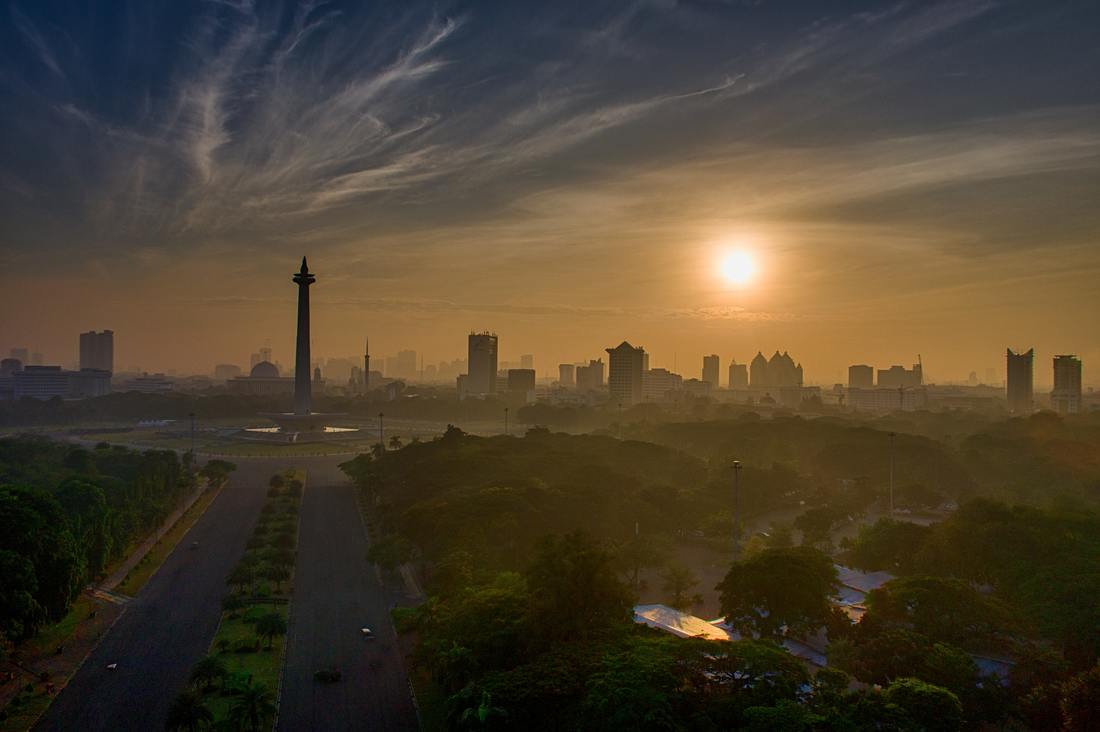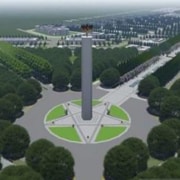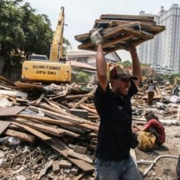
Urban forms and architectural monuments have been used to articulate what the ruling regime and elites consider the preferred image of the nation. Photo by Tom Fisk on Pexels.
Less than two weeks after the presidential election, with the official result yet to be announced, President Joko “Jokowi” Widodo declared his intention to establish a new capital city outside Java, with Kalimantan the most likely site. In an Instagram post to his 21 million followers, he questioned whether Jakarta could continue to manage the dual burden of being the administrative and business centre of the country.
Jakarta’s chronic environmental and social problems – the result of decades of mismanagement of the city’s postcolonial development and its rapid expansion – are well known. The city’s spatial and master plans have been consistently violated to allow for fluid negotiations between the city government, powerful private developers and oligarchs, while being outpaced by explosive population growth fuelled by rural-urban migration. It will be near impossible to reverse the outcomes of this long destructive process any time soon.
New urban visions for Jakarta will always be compromised by the informality of its urban governance and outpaced by the vast informal economy on which the majority of its residents rely. The city will continue to sink, floods will recur, and it will remain choked by air pollution. The urban poor will continue to demonstrate their resilience. Meanwhile, the middle class will continue to “escape” the city by surrounding themselves with sanitised and luxurious shopping malls and gated housing estates.
It is hard to imagine a megacity with such contrasting urban conditions and social ingredients ever significantly changing the course of its dysfunctional and highly politicised urban development. That is why the idea of moving the capital keeps coming up.
In fact, the idea of establishing a new capital outside Jakarta is an old story for urban historians, planners, and the general public. President Soekarno first proposed moving the capital back in 1957 when he inaugurated Palangkaraya, a city positioned in the geographic middle of the nation, as the capital of the newly established Central Kalimantan province.
Unsurprisingly, Jokowi’s announcement, the latest of many, was greeted with a wide degree of cynicism. Some critics viewed the timing of his announcement as an attempt to distract from the unfolding attempt by the Prabowo Subianto-Sandiaga Uno campaign team to challenge and delegitimise the presidential election result. Many members of the public, too, doubted Jokowi’s ability to ever realise the long-discussed plan.
Yet Jokowi has a convincing track record of implementing large scale infrastructural projects, such as the long overdue mass rapid transportation system in Jakarta, which he kick-started as Jakarta governor, and the restoration of port infrastructure and construction of major toll roads he has overseen as president. Moving the capital away from Jakarta would also be consistent with Jokowi’s commitment to infrastructure development and building Indonesia beyond Java.
Regardless of this scepticism, the proposal received widespread local and international media coverage. Professional associations, such as the Indonesian Institute of Planners (IAP), the Indonesian Institute of Urban Designers (IARKI) and the Indonesian Institute of Architects (IAI), urban planners and academics, also responded seriously, giving Jokowi’s announcement a degree of credibility that previous proposals never seemed to attract.
Regardless of the challenges involved in establishing a new capital city, the discussion about decentring Jakarta, and Java for that matter, is a valuable and healthy one to have. Java has always been important to the nation’s sense of collective identity, particularly so during the Soeharto era. The imagining of a new capital city is a valuable opportunity to discuss what could have been, what constitutes Indonesia beyond Java, and how regional Indonesians see their future as part of the nation. Pancasila’s arguably most essential but most unaccomplished fifth principle – equality and social justice for all Indonesians – cannot begin to be contemplated without decentring Jakarta and Java.
Although prompted by the troubling conditions of Jakarta, the imagining of a new capital should not be about Jakarta. Relocating the capital city will have little impact on Jakarta’s urban conditions. And neither will a new capital city replace the centrality of Jakarta in the public imagination of the nation’s modern identity. But this should not be the goal. The establishment of new capital cities in other countries, such as Canberra in Australia, Putrajaya in Malaysia and Brasilia in Brazil, did not replace the importance of cities like Melbourne, Kuala Lumpur, and Rio de Janeiro for these nations’ collective memories.
Relocating the Indonesian capital could, however, contribute to decentring Java and Jakarta, and initiate dialogue and genuine engagement with the periphery of the nation. It would involve a recognition of the marginalisation of the regions from Independence through to 1998 and a discussion about how the regions are beginning to reshape themselves in the regional autonomy era. This dialogue should be informed by critical awareness of the imbalance in power, influence, and civic infrastructure between central urban and peripheral regional locations.
The suggestion of Kalimantan as the site for the new capital has attracted considerable criticism because of the rushed and seemingly arbitrary nature of this top-down decision. Sympathetic observers note that Kalimantan is a much more stable geographical region than disaster-prone Sumatra and Java. But the argument that the capital city has to be located at the geographical centre of the archipelago is not only simplistic but also shows little regard for the complex processes behind the formation of the world’s most vibrant, successful, inclusive and liveable cities.
Cities are outcomes of complex social and historical processes combined with favourable geographical conditions, availability of resources and accessibility. Successful cities are not isolated physical entities, planned and constructed on empty land. Rather, they are shaped by, and eventually give shape to, their broader social and geographical contexts.
The choice of Kalimantan, as it has been explained so far, seems to simply replicate the path already established by Sukarno in the 1950s, a vision born in the fragile early nation-building era. If the same idea is to be relaunched 60 years later, it needs to speak to the experience of nationhood in the country today. It should also born out of a genuine engagement with the urban formation and social landscape in the chosen region.
Twentieth century postcolonial capital cities, including Jakarta, are urban formations burdened with the task of representation. They narrate and visualise certain ideas of nationalism to their own citizens, as well as the rest of the world.
Benedict Anderson has described national monuments in Jakarta as a mode of political communication, a form of symbolic speech to shape the collective awareness of the citizens. These monuments played a crucial role in ensuring the unity of the nation and in justifying the authority of the state, a crucial aspect of the early decades of postcolonial nation building.
Postcolonial nation building strategies (which were used by both Soekarno and Soeharto) have produced a capital city dominated by monumental buildings and urban spaces that exist as an articulation of the ruling regime’s version of nationhood. Civil society and the general public are often treated as passive spectators.
The urban forms of a capital also project ideas of progress and modernism, expressed through the aesthetic sensibilities of urban planners, urban designers, and architects. Symbolical urban forms and architectural monuments tower over, or in many cases marginalise and displace, pre-existing indigenous urban forms. This was the experience of Jakarta’s historical kampung neighbourhoods, for example, in the construction of the Jalan Thamrin-Sudirman district in the 1950s.
Abidin Kusno has even argued that modern architectural forms and discourse in Indonesia suffer from historical amnesia. Urban planning, design and architecture professionals lack an awareness of their roles in spatialising, visualising, and reinforcing certain power relations as envisioned by the ruling postcolonial regimes and elites.
The imagining of the new capital city should be critical of past imaginings of nationhood in Indonesia. It should be built on a more reflective reading of the forgotten past, a critical stance towards authoritarian modes of governance, and a genuine engagement with the complex social reality and experiences of being Indonesian today.
Perhaps the most worrying element of recent discussions is the envisioning of the new capital city as an entirely new and isolated entity, a new urban formation to be imagined, conceived and drawn on an empty landscape with no substantial connection to a specific historical, urban, or cultural context.
Designed capital cities like Brasilia, Canberra, and Putrajaya, while dominated by monumental architectural and urban spaces, often lack urban and civic character. Highly symbolical, they are not the most vibrant, celebrated, liveable or loved cities in their respective countries. Rather, they are often seen as symbols of state power, or in the language of our visual age, a national “brand”, which reveals little of the lived social dynamics of the nation.
Situating Indonesia’s national administrative centre in an existing historical, urban, and cultural landscape would be far more meaningful and would open up opportunities for regional Indonesia to be part of the process of envisioning a new capital. The new capital city could facilitate the emergence of a stronger civil society in regional Indonesia, one with a stronger role in imagining the future of the nation and its democracy.
A new capital city for 21st century Indonesia must move beyond postcolonial state narratives of the past. Imagine if, instead of using urban form and architecture to merely reflect what elites consider the preferred image of the nation, or relying purely on planning and design professionals’ utopian ideals, Indonesia’s new capital city were born from an open design competition combined with rigorous and genuine public and scholarly engagement. What if one of the objectives of the planning and design of the capital was to create empowering urban spaces, social and built infrastructures that served and facilitated interactions among the broad socio-economic spectrum of the city’s population. What if the new capital was a celebration of the cosmopolitan history, social dynamics and diversity of becoming Indonesia?
Instead of imposing a singular idealised version of urbanity and urban identity, a diversity of public spaces, housing models, civic infrastructure and supporting amenities are needed to ensure equal opportunities and wider accessibility. All segments of the urban and surrounding region’s populations should have the opportunity to perform their socio-economic roles in the functioning of the city and for their roles to be equally recognised.
Instead of importing abstract images of the modern and global other, the new capital should learn from the cultural layers, the street life, the human scale, the adaptability and socio-spatial features of many historical Indonesian cities. It should not hide, but provide space for, the informalities of urban life so ingrained in Indonesian cities.
After the spectacle of Jakarta, the imagining of a new capital should unfold as a genuine and grounded dialogue about the country’s multifaceted self, ambition, and possibilities. But before that, it needs to confront the realities of the country’s forgotten past and marginalised regions.







